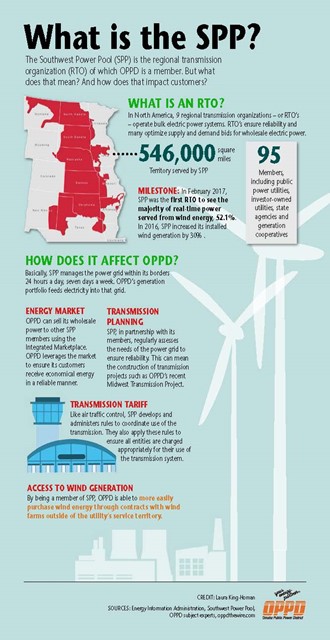- Home >
- Residential >
- Energy Efficiency >
- Energy Usage FAQ
OPPD’s Residential Rates can change depending on the time of year. For example: in the summer, OPPD’s rate for all residential customers is $0.103 (Rate 110) for every kWh (kilowatt-hour) of electricity used. For more information, please visit our Residential Rates page on our website.
The cost of electricity is affected in a variety of ways, including:
- The current rate depending on the time of year. The summer rate is generally a higher rate than the winter rate. Visit our Residential Rates pages for more information.
- Energy efficiency of your home, appliances, and electronics.
- Behavior and lifestyle. This can be broken down to the number of people in your home, the number of electronics and appliances and their efficiency, how much those items are used, and the weather.
A watt is a unit of power whereas a kilowatt-hour is a unit of energy.
One kilowatt [kW] equals 1,000 watts [w].
Kilowatt-hours represent the amount of electric usage over a one-hour period.
Example: 1,000w over a 1 hour period = 1kWh [kilowatt-hour].
- Multiply the wattage of an electric device by the number of hours you use it.
- Divide that number by 1,000. That will convert the number from watt-hours to kilowatt-hours.
- Multiply the number of kilowatt-hours [kWh] by the cost per kWh to determine the cost of using that device.
Formula: Watts x hours used ÷ 1,000 x cost per kWh = cost of electricity used
Example: Picture a home using a 2,000-watt window air conditioner, running for eight hours, and the current summer rate is $0.0936 per kWh.
~ 2,000 x 8 ÷ 1,000 x $0.103 = $1.64
~ The cost to run the window AC for eight hours is $1.64
Use our Electric Usage Calculator to better understand how much energy any of your electronic devices or appliances use.
Through a MyAccount enrollment, you can view the last 24 months’ of your OPPD bills, or you can view your usage history over the same period of time.
Once you have logged into your MyAccount, use the left-hand side menu to “View My Bill” or “View My Usage”.
Phantom Load or Vampire Power is the name for the energy used from an electronic device that is turned off but still plugged in.
Below is a list of items and how much energy (in watts and dollars) they use over a 24-hour period of being turned off but still plugged in.
- Cell Phone Charger
- 0-9 watts
- Up to $0.02/day or $0.64/month
- Entertainment Center (TV, 2 gaming systems, sound system and 2 lamps)
- 408 watts
- $0.04/day or $1.32/month
- Computer Setup
- 240 watts
- $0.02/day or $0.78/month
Note: These figures do not include usage when they are in use. These figures are for the energy usage and cost of an electronic device turned off but still plugged in.
Phantom Load – Should I unplug items I am not using to save electricity?
There are a few things to consider before turning off a power strip or unplugging an item due to Vampire Load: quantity and time.
Using the entertainment center example above, we can determine the actual amount that would be saved by turning it off at the power strip when not in use.
- Hours/day used: 8
- Usage and cost per hour: 17 watts per hour = 0.02 kWh x 0.1095 = $0.002 (2/100 cent) per hour
- Hours not in use: 16 hours
- 16 x 17 watts = 272 watts = .272 kWh per day
0.272 kWh x 0.1095 (summer 110 residential rate) = $0.03 per day saved or $0.89 per month saved
As mentioned above, quantity plays a role. Depending on how many of those setups you have, the $0.89 per month could add up. It is recommended to simply turn off items not in use to conserve energy versus unplugging them.
Ultimately, a high bill is not generally caused by Phantom Load. Phantom Load can cost you $1.00 to $10.00 extra per month, but that all depends on how many setups you may have, how long they are in use for versus not in use and whether they’re being turned off or not.
The summer and winter months can be prime seasons for high usage bills depending on your heating and cooling setup. For all customers with air conditioning, the summer generally produces higher usage bills. In the winter, customers with heat pumps or electric heating (electric resistance heating, Geothermal heating, etc.) will see higher usage bills.
Below we have outlined some of the higher usage items (when in use). Time plays a big role in a higher usage bill. The longer an item is used the more energy it will use, especially in adverse weather when an air-conditioner or electric furnace may need to run more often than normal.
Please note: these numbers are generalized numbers. Each item will have details printed on them detailing the exact amount of energy they use.
- Electric Furnace
- 1,000 sq. ft. home: 8,000 watts
- 2,000 sq. ft. home: 26,000 watts
- Blower: 750 watts (both electric and gas furnace)
- Air-Conditioning
- Central Air Unit – 2.5 tons: 3,500 watts
- Large Window Unit: 1,500 watts
- Small Window Unit: 900 watts
- Major Appliances
- Electric clothes dryer: 4,500 watts
- Electric Water Heater: 3,800
- Refrigerator: 200-700 watts
For more information on how to reduce your energy usage, please visit our Energy Efficiency Videos page.
Have other home energy usage questions?
If you have other questions, please email customerservice@oppd.com. You will be contacted within 1-2 business days. Or you may contact the customer service team by phone at (402)536-4131 or outside the metro at (866)536-4131.


